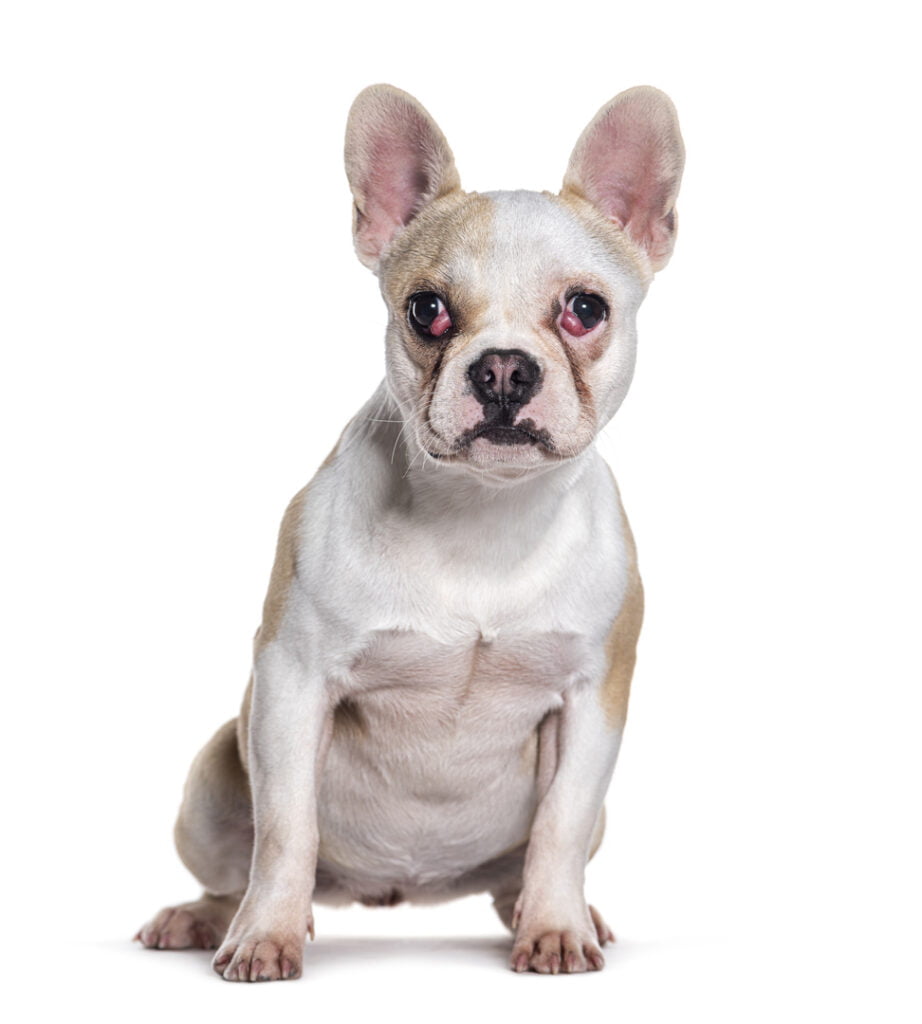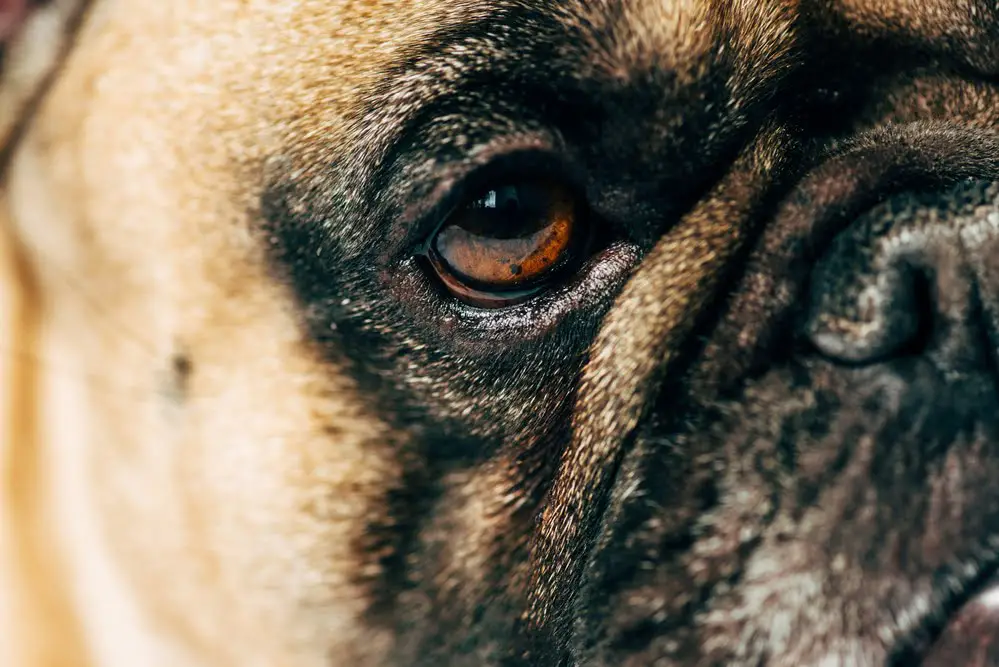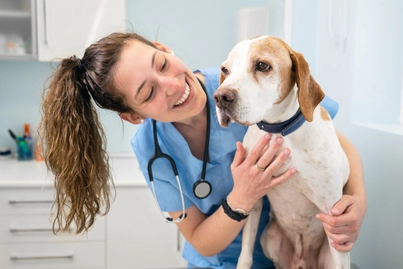There’s not much worse than your usually fun-loving, cuddly pet facing a health problem. Unfortunately, with good comes bad sometimes.
Frenchies are prone to several health problems, and a common one is the French Bulldog cherry eye. Of course, other breeds can also experience this nagging eye issue.
The good news is that being in the know of potential health issues means you’re able to handle it better in order to get your pup back to their usual self.
Let’s get down to it and get answers to questions regarding the French Bulldog cherry eye.
A French Bulldog’s Third Eyelid
It’s because of a third eyelid that dogs can develop cherry eye.
All dogs, including Frenchies, have a third eyelid. Their third eyelid, also known as the nictitating membrane, has a tear gland attached to its base, which produces some of a dog’s tears. This third eyelid also sweeps across the eyes to clean and protect them.
If your French Bulldog’s third eyelid is visible, there’s a chance it has cherry eye.

What is French Bulldog Cherry Eye?
Cherry eye occurs when the third eyelid prolapses or moves out of place, and its cartilage folds over, taking away its ‘sweeping’ function, which typically cleans off the eyelid. The gland becomes exposed and inflamed. As it swells up, a red mass protrudes from the eye. Cherry eye can occur in one or both eyes.
While cherry eye can affect a Frenchie at any age, it’s most common in puppies up to a couple of years old.
Is it Harmful?
While French Bulldog cherry eye is a condition you need to address immediately, it’s one that can be treated and won’t have major effects if you get it taken care of.
A problem occurs only when you leave it untreated because the tear production decreases and can lead to incomplete closure of the eye. As a result, dry eye and eye infections can occur. Pain, pigmentation of the eye, and/or blindness can also take place.
Connect with a verified veterinarian in minutes. No waiting for appointments or office hours. No high fees. Your pet's health made convenient and worry-free.
Causes
While there doesn’t seem to be a particular cause of French Bulldog cherry eye, there are some ideas on why this health issue can occur.
Since cherry eye appears across particular breeds, like the French Bulldog, it’s categorized as a congenital defect and is said to be genetic.
With that said, cherry eye is most commonly thought to be passed from parent to puppy, and when tissue that is holding the nictitating membrane in place weakens, it starts to pop out of place.
French Bulldogs are more prone to weakened tissue fiber than some other breeds, which is why cherry eye is common for them.
Other reasons for a mass on the eye that may appear to be cherry eye could be cartilage turned inside out inside the third eyelid, abnormal cells in the third eyelid, or prolapse of fat in the eye. Of course, your vet can determine the actual cause and if the mass is cherry eye or another issue.
Symptoms
French Bulldog cherry eye is typically quite easy to notice. Usually, the swelling is so intense that it continuously protrudes above the third eyelid, which means the mucous membrane is constantly exposed to dehydration and debris.
There are also times when the tear gland drops back to its normal place behind the third eyelid, and you may not notice the cherry eye.
Cherry eye is sometimes large and covers a large part of the eye, while other times it’s so small that you barely notice it.
Fortunately, one or more of the following symptoms will appear, and you’ll know there’s an issue to address.
- Redness of the eye
- Squinting
- Pawing of the eye
- Dry eyes
- Discharge
- Swollen eye or swelling around the eye
- Abundant tear production
Diagnosis
As we mentioned, there’s not just the one issue of cherry eye that could occur. Several issues may cause eye problems. If you begin to notice any of the above symptoms, visit your vet for a proper diagnosis.
Connect with a verified veterinarian in minutes. No waiting for appointments or office hours. No high fees. Your pet's health made convenient and worry-free.
For the most part, the diagnosis of the French Bulldog cherry eye is fairly straightforward. Your vet will examine your Frenchie’s eye to diagnose cherry eye. Additionally, the vet may perform other diagnostics to determine the overall health of the eye.
Since cherry eye decreases tear production, your vet may perform a Schirmer tear test which measures a dog’s tear production. This will determine if your pup is experiencing dry eye. Additionally, a florurescien stain test can be performed to look for cornea scratches. This is important to test because the scratches are painful but can also turn into ulceration, infection, and perforation if not treated.
Treatment
The reason for treating cherry eye is so that the bulging tear gland can return to its normal position. Treatment can quickly begin once your vet has determined that the issue is, in fact, cherry eye.
Treatment depends on severity.
Mild Cases
Mild cases are usually treated with anti-inflammatory drugs to reduce the swelling of the gland, or anesthesia is provided, and your vet will try to return the tear gland to the proper place. This fix doesn’t always last, and surgery may be needed.
Eyedrops can reduce discomfort in the eye, remove debris, and eliminate tear stains.
Moderate to Severe Cases
Moderate or severe cherry eyes usually require surgery. During surgery, the goal is to place the gland back into the appropriate position in a ‘pocket’ behind the third eyelid. This is not always possible, and if the case is too severe or chronic, the gland may need to be completely removed from the eyelid.
No surgery technique is guaranteed to fix the issue or prevent cherry eye from occurring again. Because of this, your Frenchie should continue to be monitored closely. There’s also always a chance that the mass occurs in the other eye.
While you can’t prevent the prolapse from happening again, the sooner you bring attention to any issues, the better chance you can reduce or prevent damage to the cornea.
Recovery after Surgery
If you and your vet decide on the surgery route, there are things to know about recovery. First and foremost, your Frenchie will need to wear an E-collar, or cone, during recovery for a couple of weeks or so. The cone will prevent your pup from bothering their surgery site, which could cause irritation or other harm. The cone helps ensure timely recovery and reduced the risk of infection.
Plan to revisit the vet several times for follow-up appointments. Your vet may also prescribe pain medicine to allow your pet to be comfortable as it recovers.
Untreated French Bulldog Cherry Eye
By now, we know that the best response to symptoms of cherry eye is to contact your vet immediately. There are many reasons not to leave cherry eye untreated.
- Uncomfortable dry eye (can lead to pigmentation of the eye and blindness)
- Incomplete closure of the eye due to decreased tear production
- Restricted blood flow of the nictitating membrane
- Impaired vision due to persisting Inflammation
French Bulldog Cherry Eye FAQ
Still, have some questions? Here are some answers to common cherry eye questions.
Can cherry eye be prevented?
Since cherry eye is a genetic trait, it cannot be prevented. Since you know French Bulldog cherry eye is common, make a habit of regularly checking your dog’s eyes. If you notice any issues, eye drops and placing a wet, warm cloth over the eye, and gently massaging are ways to relieve discomfort at home and allow tears to produce. Overall, seeing a vet is best for proper treatment.
How much is surgery for cherry eye?
The average cost of surgery is $300-$800, but this could vary. An eye specialist may charge more.
Does pet insurance cover cherry eye surgery?
Most pet insurance will assist in surgeries like this one for your pet if it’s not a preexisting condition. Getting pet insurance is sometimes forgotten or not a high priority, but it can be very helpful for situations like French Bulldog cherry eye.
Is cherry eye a tumor?
You may hear growth and instantly think tumor. The good news is that cherry eye is not a tumor but simply a normal tear gland positioned in the wrong place. Its exposure to air is what causes issues such as swelling.
Is cherry eye painful?
Typically, cherry eye is not too painful. It can be itchy and uncomfortable. As mentioned, cherry eye can become more irritating if left untreated for too long.
Is cherry eye contagious?
No, cherry eye is not contagious from one dog to another or to a human. However, breeders should be aware if a breeding dog has a history of cherry eye and avoid passing the condition on.
Final Thoughts
French Bulldog cherry eye is certainly not fun to deal with. But now we know exactly what it is, how easily it can be detected, how it’s diagnosed and treated, and many other answers to common curiosities. The bottom line is that if you treat it as soon as possible, there should be no major concerns.
For some fun stuff on the adorable French Bulldog, check out 20 Awesome French Bulldog Toys.

